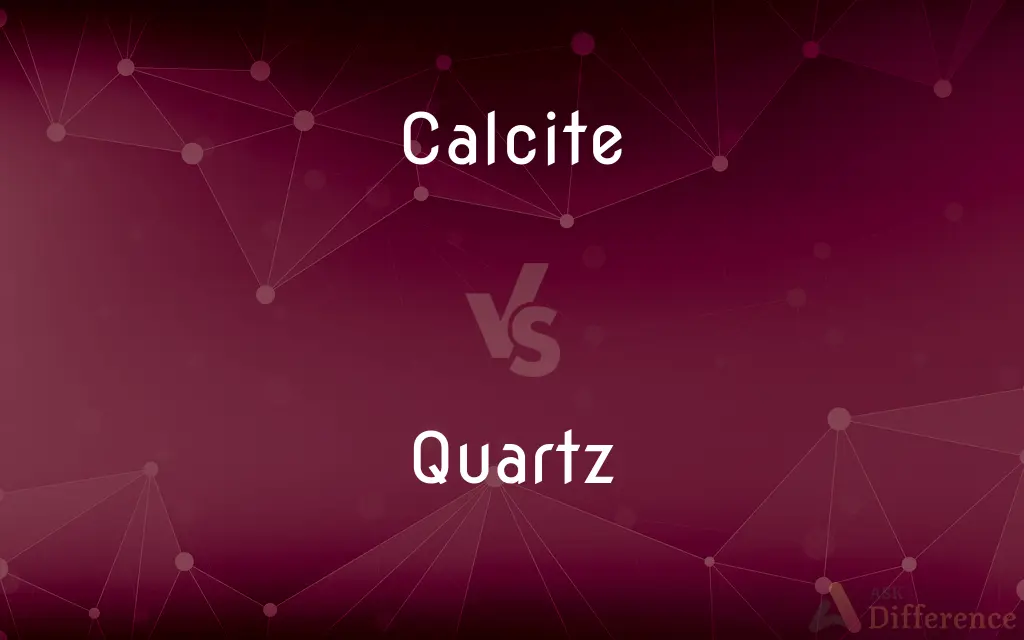Calcite vs. Quartz — What's the Difference?
Edited by Tayyaba Rehman — By Urooj Arif — Updated on March 15, 2024
Calcite is a carbonate mineral with high reactivity to acids, while quartz is a silicate known for its hardness and resistance to weathering.

Difference Between Calcite and Quartz
Table of Contents
ADVERTISEMENT
Key Differences
Calcite, composed primarily of calcium carbonate, is known for its relatively soft nature (Mohs hardness of 3) and its chemical reactivity, particularly with acids, causing it to effervesce. On the other hand, quartz is a hard mineral (Mohs hardness of 7) composed of silicon dioxide, notable for its durability and resistance to chemical weathering, making it one of the most abundant minerals in the Earth's crust.
While calcite is often found in sedimentary rocks such as limestone and is a primary component of marine organisms' shells, quartz is more widespread in igneous and metamorphic rocks. Quartz's resistance to weathering makes it a common component of sand and sediment, whereas calcite's solubility in water plays a crucial role in the formation of caves and karst landscapes.
Calcite exhibits a wide variety of crystal forms and colors, including transparent, white, pink, blue, and green varieties. It also demonstrates strong birefringence, causing objects viewed through a clear piece to appear doubled. Quartz, while also variable in color, ranging from clear to black, including well-known varieties like amethyst (purple) and citrine (yellow), does not exhibit birefringence but can form hexagonal crystals and is known for its piezoelectric properties, which have practical applications in electronics.
In terms of uses, calcite is critical in the manufacture of cement and as a balancing material in various chemical processes due to its acid-neutralizing capabilities. Quartz, with its hardness and chemical stability, is used in a wide range of industrial applications, including glass making, electronics, and as an abrasive.
The optical properties of calcite, such as its ability to polarize light, make it valuable for scientific instruments, whereas quartz is extensively used in timekeeping instruments due to its piezoelectric qualities, which allow it to maintain a precise frequency standard.
ADVERTISEMENT
Comparison Chart
Composition
Calcium carbonate (CaCO₃)
Silicon dioxide (SiO₂)
Mohs Hardness
3
7
Reactivity to Acids
High (effervesces with HCl)
Low (resistant to chemical weathering)
Common Colors
Transparent, white, pink, blue, green
Clear, purple (amethyst), yellow (citrine), black
Optical Properties
Strong birefringence
Piezoelectricity, no birefringence
Uses
Cement manufacture, acid neutralization
Glass making, electronics, timekeeping
Typical Formation
Sedimentary rocks, marine shells
Igneous and metamorphic rocks
Crystal System
Trigonal
Hexagonal
Weathering Resistance
Low
High
Compare with Definitions
Calcite
A carbonate mineral known for its softness and reactivity to acids.
Calcite reacts vigorously when hydrochloric acid is dropped on it.
Quartz
Forms in a wide variety of colors and types.
Amethyst, a popular purple variety of quartz, is used in jewelry.
Calcite
Exhibits birefringence, causing double images.
Scientists use calcite crystals in optical equipment to study light polarization.
Quartz
Resistant to weathering, contributing to sand formation.
Much of the world's beaches are composed of quartz sand due to its durability.
Calcite
Commonly found in limestone and marble.
The Taj Mahal's white gleam is due to its marble, rich in calcite.
Quartz
A hard, crystalline mineral composed of silicon dioxide.
Quartz countertops are prized for their durability and resistance to scratches.
Calcite
Essential in the manufacture of cement.
Calcite is ground into a fine powder and used as a primary ingredient in cement.
Quartz
Predominantly found in igneous and metamorphic rocks.
The beautiful, clear crystals in granite are often quartz.
Calcite
Contributes to the formation of stalactites and stalagmites in caves.
Water dripping through limestone dissolves calcite, which re-deposits to form cave features.
Quartz
Utilized in electronics for its piezoelectric properties.
Quartz crystals are essential for maintaining accurate time in watches.
Calcite
Calcite is a carbonate mineral and the most stable polymorph of calcium carbonate (CaCO3). The Mohs scale of mineral hardness, based on scratch hardness comparison, defines value 3 as "calcite".
Quartz
Quartz is a hard, crystalline mineral composed of silica (silicon dioxide). The atoms are linked in a continuous framework of SiO4 silicon-oxygen tetrahedra, with each oxygen being shared between two tetrahedra, giving an overall chemical formula of SiO2.
Calcite
A common crystalline form of natural calcium carbonate, CaCO3, that is the basic constituent of limestone, marble, and chalk. Also called calcspar.
Quartz
A very hard mineral composed of silica, SiO2, found worldwide in many different types of rocks, including sandstone and granite. Varieties of quartz include agate, chalcedony, chert, flint, opal, and rock crystal.
Calcite
(mineral) a very widely distributed crystalline form of calcium carbonate, CaCO3, found as limestone, chalk and marble
Quartz
(mineral) The most abundant mineral on the earth's surface, of chemical composition silicon dioxide, SiO2. It occurs in a variety of forms, both crystalline and amorphous. Found in every environment.
Calcite
Calcium carbonate, or carbonate of lime. It is rhombohedral in its crystallization, and thus distinguished from aragonite. It includes common limestone, chalk, and marble. Called also calc-spar and calcareous spar.
Quartz
Crystal meth: methamphetamine hydrochloride.
Calcite
A common mineral consisting of crystallized calcium carbonate; a major constituent of limestone
Quartz
A form of silica, or silicon dioxide (SiO2), occurring in hexagonal crystals, which are commonly colorless and transparent, but sometimes also yellow, brown, purple, green, and of other colors; also in cryptocrystalline massive forms varying in color and degree of transparency, being sometimes opaque.
Quartz
Colorless glass made of almost pure silica
Quartz
A hard glossy mineral consisting of silicon dioxide in crystal form; present in most rocks (especially sandstone and granite); yellow sand is quartz with iron oxide impurities
Common Curiosities
How do the optical properties of calcite and quartz differ?
Calcite exhibits birefringence, splitting light into two rays, while quartz has piezoelectric properties but does not show birefringence.
What distinguishes calcite from quartz in terms of chemical composition?
Calcite is primarily calcium carbonate, whereas quartz is made of silicon dioxide.
Can the hardness of calcite and quartz affect their practical uses?
Yes, quartz's greater hardness makes it suitable for durable surfaces and precision instruments, while calcite's softer nature limits its use to less abrasive applications.
How do the crystal systems of calcite and quartz differ?
Calcite crystallizes in the trigonal system, while quartz forms hexagonal crystals.
How are calcite and quartz formed?
Calcite is typically formed in sedimentary environments, especially in limestone, while quartz is common in igneous and metamorphic rocks.
Why is calcite more reactive to acids than quartz?
Calcite contains carbonate ions that react with acids, releasing carbon dioxide gas, unlike quartz's stable silicon-oxygen bonds.
What is the significance of birefringence in calcite?
Birefringence in calcite has applications in optical instruments, allowing for the study of light polarization.
What environmental conditions favor the formation of calcite?
Calcite forms in sedimentary environments, often as a result of biological processes in marine settings.
Why is quartz more abundant in sandy environments than calcite?
Quartz's high resistance to weathering allows it to persist in sedimentary environments, while calcite is more likely to dissolve in water.
Why is quartz preferred in electronics?
Its piezoelectric properties allow quartz to generate an electrical charge under mechanical stress, useful for precise frequency standards.
What role does calcite play in water chemistry?
Calcite can neutralize acids, making it important in balancing pH in water treatment and natural water bodies.
Is there a difference in the piezoelectric properties between calcite and quartz?
Only quartz exhibits piezoelectric properties, making it unique for applications in electronics and timekeeping devices.
How does the weathering resistance of quartz benefit its usage in construction?
Quartz's resistance to weathering makes it ideal for use in construction materials that require durability and longevity.
Can the color of calcite and quartz be used to distinguish them?
While both can vary in color, their physical properties and reaction to acids are more reliable distinguishing factors.
Why is quartz used in making glass?
Its chemical stability and transparency make quartz ideal for the high heat processes involved in glass making.
Share Your Discovery

Previous Comparison
Cyclohexane vs. Benzene
Next Comparison
Noise vs. SoundAuthor Spotlight
Written by
Urooj ArifUrooj is a skilled content writer at Ask Difference, known for her exceptional ability to simplify complex topics into engaging and informative content. With a passion for research and a flair for clear, concise writing, she consistently delivers articles that resonate with our diverse audience.
Edited by
Tayyaba RehmanTayyaba Rehman is a distinguished writer, currently serving as a primary contributor to askdifference.com. As a researcher in semantics and etymology, Tayyaba's passion for the complexity of languages and their distinctions has found a perfect home on the platform. Tayyaba delves into the intricacies of language, distinguishing between commonly confused words and phrases, thereby providing clarity for readers worldwide.
















































